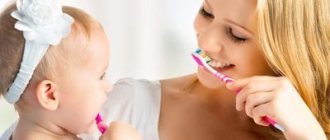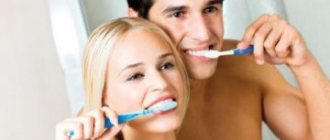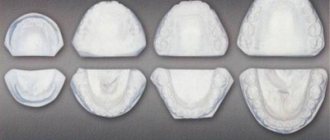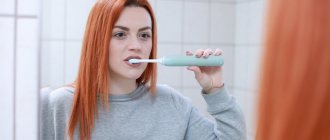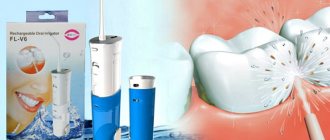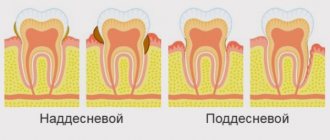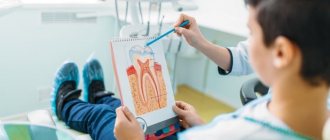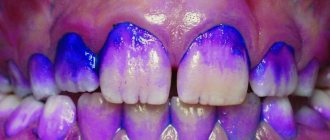Not all parents know how to properly brush their children’s teeth, but the condition of the erupted permanent teeth depends on the quality of care for baby teeth.
. To protect your child from problems with molars, incisors and canines, it is necessary to teach him to brush and rinse his mouth after the very first tooth erupts.
Features of the structure of milk teeth
Baby teeth form in the sixth week of fetal development. Normally there are 20 of them:
- 8 molars;
- 8 incisors;
- 4 fangs.
Temporary teeth consist of the same tissues as permanent teeth:
- dentin (in temporary teeth it is softer and less mineralized);
- enamels;
- pulp.
However, primary incisors, canines and molars have features:
- low crowns;
- large distance between crowns;
- long thin roots that dissolve before the temporary tooth falls out and the permanent tooth erupts;
- thin enamel - only 1 mm;
- wide channels.
The structure of baby teeth is only slightly different from permanent teeth, so they no less need proper care. You can start brushing your child’s teeth after the very first incisor has erupted.
. Early training in hygiene will be an excellent prevention against many dental diseases that can affect the primary incisors, and then the rudiments of the permanent ones formed under them.
If you don’t care for your baby’s teeth or care for them incorrectly, your baby will have to visit pediatric dentists already in the first three years of life. Or he may tolerate drilling rotted teeth with a bur, which is painful and unpleasant for a small child, even with high-quality anesthesia.
Children's electric toothbrush
There are electric options for oral cleaning devices for children aged 3 years and older. These models operate on batteries and, thanks to vibration, effectively clean your teeth. They make 7,000 movements per minute, which helps remove plaque. There are different bristle options, such as artificial fibers or natural ceramics. The latter are a source of negative ions, which effectively resist plaque and unpleasant odors.
It is very important to pay attention to the bristles, which should be slightly rounded and soft to the touch so as not to damage the enamel. It is important to pay attention to the central row of bristles, which are traditionally longer than the rest. This is necessary in order to effectively clean the most problematic area for children - the chewing surface.
Maximum safety should also be ensured due to the plastic, hypoallergenic, waterproof housing.
The presence of a musical timer in electric toothbrushes will help children determine the time of the brushing procedure.
Among the additional positive aspects of such brushes for children, it is worth noting the presence of a musical timer that can turn on funny melodies every minute so that the child shows interest in this hygiene procedure. After 2 minutes, the timer signals the end of the procedure.
Reference. Modern models even have special indicators in the form of bristles to monitor the effectiveness of cleaning. With proper cleaning twice a day, after 3 months the indicators should be discolored by 50% of their length.
How to properly clean a baby's mouth
Immediately after being discharged from the hospital, you need to start wiping the newborn baby’s gums with a thick gauze swab dipped in water. You can also wet the tampon in:
- chamomile infusion, if the baby does not have constipation;
- bactericidal infusion of sage;
- St. John's wort decoction, as this plant strengthens the gums;
- anti-inflammatory decoction of calendula.
It is not recommended to use decoctions and infusions of herbs to treat the oral cavity of a baby more than 2-3 times a week, as their abuse can lead to allergic reactions.
Maintaining hygiene, which involves treating the oral mucosa with a gauze swab, is necessary for both newborns who are breastfed and those children who are fed artificial formula. Breast milk does not clean the oral cavity, but pollutes it. If you do not sanitize your baby’s mouth after feeding, then pathogenic bacteria will begin to multiply in it, which can lead to infection of the tooth enamel.
Ionic toothbrushes for children
Innovative development, like many other similar things, came to us from Japan. The principle of operation is as follows. Devices based on ionization have long been used in everyday life and even medicine. This technology provides a large number of positive effects for the growing child’s body. The ionic brush leaves no chance for bacteria to grow. There is a metal plate on the handle of the brush and as soon as the child comes into contact with it, the bristles transmit a completely harmless and imperceptible electrical charge of 1.5 μA. Thanks to this, the polarity of the tooth surface changes to positive, which allows it to attract not only plaque, but also pathogenic bacteria. The principle of operation of such a brush is similar to a vacuum cleaner, which attracts all the dirt. The child does not experience any discomfort during this process. But due to the fact that even the most inaccessible places are cleaned, this option is the most effective, as evidenced by clinical studies:
- Tooth sensitivity is reduced by 61%
- Reduces gum bleeding by 52%
- Plaque removal efficiency increases by 49%
It is noteworthy that such results can be obtained almost immediately. Among other things, such a brush can be used for other therapeutic procedures:
- Acupuncture therapy
- Galvanization
- Electrophoresis
Acupuncture therapy
The positive effect is ensured through a direct effect on BAP (biologically active points).
There are a large number of BAPs in the oral cavity, which are activated due to the influence of electric current from the electronic brush.
Thanks to this, not only an “energy recharge” occurs, but also an activation of the immune system and vitality.
Galvanization
It implies an effect on the tissues of the oral cavity, due to which it is possible to relieve inflammation, pain due to increased sensitivity of tooth enamel, and bleeding gums.
At what age should a child start brushing his teeth?
You need to start brushing your baby's teeth from the moment they begin to erupt.
At first, it is better to perform manipulations without paste, carefully treating not only the first tooth, but also the gum itself. You can use a special soft baby brush or a silicone pad that is placed on the parent’s finger. The last device will serve not only as a brush, but also as a gum massager, which will ease the pain from teething.
You should act carefully during the cleaning process, since the gums near the cutting tooth are inflamed and painful, so infants may react poorly to the hygiene procedure. But you cannot refuse it: during teething, local immunity deteriorates, so the risk of infection of the enamel increases.
More details about caring for the oral cavity of a newborn are described in the video:
Subtleties of choosing a silicone fingertip
The silicone fingertip is the very first toothbrush in a child’s life. It is clear that a one-year-old baby will not yet be able to independently engage in oral hygiene, so parents should do this for him. The accessory is put on mom or dad’s finger, after which the parent brushes the child’s teeth.
When choosing such an accessory, it is worth considering the following features:
- The product must be made entirely of silicone - even the bristles. Only in this case will it preserve the health and integrity of the soft tissues, and the parent will be able to properly control the degree of pressure;
- The fingertip should not have any noticeable seams. Bacteria and other harmful microorganisms can accumulate in such irregularities;
- It is advisable that the kit include a special case for storing the finger brush.
Before and after use, the finger brush and hands must be thoroughly washed with soap and water. No toothpaste required. Cleaning should be done slowly, using massaging rather than traditional sharp movements.
How to properly brush children's teeth
There are several general rules for high-quality teeth cleaning, depending on the age of the baby:
- A child under one year old should brush his teeth using a special silicone pad, which is fixed on the parent’s index or thumb.
- After a year, you can use a brush with silicone bristles and a special limiter, gradually switching to classic models.
- From the age of three, a regular brush with soft bristles is used. It is important that its surface is covered only by two dental crowns, otherwise the hygienic procedure will not be effective enough.
A baby brush needs to be changed every 3-4 months. If the service life has not yet expired, but the brush has already become rough around the edges, you should change it, since pathogenic bacteria can begin to form and multiply between the bristles.
How to brush the teeth of a child under 1 year old
Six months is the age when parents should start brushing their child’s teeth every day.
From 6 to 12 months, children are cutting teeth, so during this period it is necessary to sanitize their oral cavity very carefully. The baby cannot yet take part in the hygiene procedure, but can already express his dissatisfaction with sounds and gestures, so the adult should focus not only on the dental cleaning technique, but also on the baby’s sensations.
How to properly brush your first teeth
Key cleaning rules:
- the necessary movements should be sweeping: from the root to the top;
- the finger with the silicone attachment should be in the child’s mouth at an angle of 45 degrees to the gums;
- when processing chewing surfaces, the finger with the nozzle is positioned horizontally and cleans the crown with progressive longitudinal movements;
- The inner surface of the teeth is cleaned with short, quick movements;
- The side teeth can be cleaned using circular movements.
There should be about 10–15 movements per tooth. During the procedure, it is necessary to clean not only the dental enamel, but also the inner surface of the cheeks, tongue and gums. You can also brush your one-year-old child's teeth using special dental wipes, which can be purchased at the pharmacy.
Why you need to teach your child to brush their teeth earlier than one year
You should start brushing your baby's baby teeth when the first incisor appears or even before it fully erupts. Complete oral care will help:
- form the correct bite;
- It is good to clean the oral cavity from cariogenic bacteria;
- prevent various diseases, including caries.
How to brush teeth for children over one year old
A child over 1 year old can purchase their first toothbrush with silicone bristles. It costs more than a regular one, but such a waste of money is justified: a brush with silicone bristles will not injure the child’s teeth and will help to thoroughly clean the gums and cheeks. You can use it to clean even your child’s first teeth. However, such brushes quickly become unsuitable for safe use, so they should not be used for a long time.
Rules for caring for a children's toothbrush with silicone bristles
In order for the silicone brush to last longer, you must follow the following rules for its operation:
- Do not boil or even simply pour boiling water over the brush;
- After each use, you should wash it with soap (baby, tar, laundry).
The brush should not be placed in a case; it should be stored in a closed cabinet, in a glass, separately from the brushes of adult family members.
Budget segment
Aquafresh My baby teeth
This product is designed for children aged three to five years, that is, they are already quite independent and are able to take care of themselves, including brushing their teeth. Available with bright caps made in the shape of animal heads. The brushes themselves are painted in eye-catching colors and different patterns, so kids will have fun caring for their teeth with these products.
More: Top 10 best walkers for children: how to choose baby walkers
The handle here is very comfortable; it consists almost entirely of rubber inserts, so it will not slip even in wet children’s fingers. There is a suction cup on the base - the brush does not have to be put away in a cup, but can simply be stuck on the wall or on the sink. The bristles here are very soft, made of silicone, and practically do not wear off during use.
Advantages:
- The original protective cap is provided;
- Very carefully cares for children's teeth and gums;
- Attractive appearance;
- The ergonomics of the handle and suction cup are carefully thought out.
Flaws:
- The product quite quickly loses its original appearance;
- Relatively rigid connection between head and handle.
Aquafresh toothbrush My baby teeth
Colgate SpongeBob
The first electric model in our review, powered by standard batteries or traditional AA batteries. Despite its quite reasonable cost, such a brush functions very effectively. It cleans teeth thoroughly and efficiently - removing much more plaque and pathogenic bacteria than a standard toothbrush. This device is equipped with a small vibrating head. Despite the fact that it rotates quite quickly, the enamel remains intact.
The bristles are made of soft rubber, which are at a slight angle to each other. The handle of the device is of high quality, its shape is carefully thought out, so the child can easily use it independently. These products are suitable for children aged 3 years and older.
Advantages:
- Very beautiful and bright design;
- Batteries are included with the toothbrush;
- Reasonable price.
Flaws:
- There is no battery charge indicator;
- There is only one nozzle, and it is not possible to change it if necessary;
- There is no automatic shutdown timer for the device.
Colgate SpongeBob Toothbrush
Bebe comfort
The set comes with two comfortable, interesting and not quite ordinary toothbrushes from a well-known French manufacturer. One product has bristles made of silicone, the other of ordinary materials. It is worth noting that the manufacturer recommends using such products also for teething. The product handle is made of rubberized materials and has an ergonomic shape. Thanks to this solution, the brush will not slip out even from wet hands, so the likelihood of injury to the oral cavity is reduced to almost zero.
The brushes are very ordinary, they do not contain any electrical elements, so they are prepared for use in the simplest way: boiled in water for several minutes. It is worth noting that this brush can be used starting from the age of three months.
Advantages:
- The set includes two easy-to-use brushes, and each of them has a case;
- Convenient and easy to sterilize;
- Can be used for teething;
- Safe and versatile in use.
Flaws:
- The bristles are quite hard.
Bebe confort toothbrush
BABYONO
In second place in this section of our review of the best toothbrushes for children is also a set presented with three accessories at once, each of which will correspond to a certain age of the child. Such a solution from the manufacturer will be a very convenient and practical purchase, since the baby’s parents will no longer have to constantly search for and purchase toothbrushes for a new stage of dental and oral care.
The set includes a special massager suitable for the period when the child is cutting his first teeth. It will also provide complete care for the baby's gums. The silicone brush for the first teeth is made from the safest materials that will not cause an allergic reaction or irritation. The bristles themselves are very soft. The third toothbrush is designed for effective and high-quality oral care in older age. The brushes are made in a variety of colors and are characterized by a comfortable handle.
More: TOP 10 auto tracks for children: how to choose a good children's auto track
Advantages:
- The set contains the entire set of brushes that will be useful to the baby, starting literally from the moment of birth;
- The products are absolutely safe;
- Very comfortable handle.
Flaws:
- It is not found everywhere, although it is not very expensive.
BABYONO toothbrush
PresiDENT Kids-Junior
This brush is best suited for children aged 5 to 11 years; it is characterized by a very bright design and is intended exclusively for self-cleaning teeth, oral care, and so on. The handle is thick and has soft rubber inserts. On the front side you can find a slope for the thumb, on the back side there are waves for convenient placement of the remaining fingers. The head has a cone shape. The bristles are soft and graduated, made of high quality nylon, and have rounded tips.
The bristles here are divided into two bundles - upper and lower. The first one has small overall dimensions and is blue in color, the second one is larger and painted white. Both of these units are designed to thoroughly remove even the smallest food debris in the interdental spaces, effectively cleaning the back teeth. The weight of the product is only 25 grams with a length of 14.5 cm. A protective cap can also be found in the kit.
Advantages:
- Beautiful appearance that will be maintained throughout its entire service life;
- Carefully but thoroughly cares for teeth, gums and the entire oral cavity;
- Reasonable cost;
- Includes a cap for convenient storage;
- The handle will not slip in your palms.
Flaws:
- Not detected.
Toothbrush PresiDENT Kids-Junior
Toothpastes for one-year-old children and infants
To start brushing children's teeth using toothpaste, it is not necessary to wait until the child is one or three years old. Most toothpastes are indicated for children over 2 years of age, however, there are a number of manufacturers whose product lines include good fluoride-free toothpastes suitable for children under one year of age. They are completely harmless and can be swallowed. Such products can be found among the brands:
- ROCS
- Elmex.
- Splat.
- Lacalut.
Each toothpaste indicates at what age it is approved for use - you need to brush your child’s teeth only with a product that is not contraindicated for him and is suitable for comprehensive care of children’s teeth.
When starting to brush the teeth of a child under one year old using toothpaste, you need to monitor his reaction. Some babies may develop allergies, so at the first symptoms of a rash or an incomprehensible cough, you should stop using the paste and show your baby to a doctor.
First toothbrush for a child: when to buy and which one to choose
Many parents are under the misconception that they should start brushing their teeth as soon as they appear. In fact, it is necessary to do this from the first months of the baby’s life. Only instead of a brush, special wipes are used to clean babies’ teeth, gums and tongue. ASEPTA® Baby wet wipes have proven themselves excellent in this regard, which experts recommend for children from 0 to 3 years old. They allow you to effectively remove food debris and carry out oral hygiene for your child.
For cleaning the teeth of children over 6 months old, a silicone toothbrush that fits comfortably on your finger is suitable. With its help, simultaneously with the hygiene procedure, the gums are massaged, which is especially important during periods of teething. Fingertips for cleaning children's teeth are convenient and simple; they can be used until the child learns to brush his teeth himself. This usually occurs around the age of one and a half to two years.
Everyone understands that a child at this age will not yet be able to brush his teeth correctly, and parents will have to finish the “work” for him. Still, you shouldn’t delay getting used to doing the procedure yourself. The sooner you instill in your baby the healthy habit of brushing his teeth, the less hassle there will be later.
The first full-fledged brush must meet the following requirements:
- have soft and well-polished rounded bristles in an amount of about 20 tufts - this will avoid damage to the gums;
- differ in the small size of the head - it is enough for it to be comparable to two baby teeth;
- have a handle that is comfortable for a child to hold independently, preferably non-slip.
Manufacturers of toothbrushes for children pay special attention to their design. Children are delighted with toy brushes made in the shape of a character from their favorite cartoon or fairy tale. Attractive designs often decorate the handles of children's brushes. Undoubtedly, the aesthetic side is also important, because it helps to instill interest in the process of brushing your teeth, but still, first of all, when choosing a brush, you need to focus on its technical characteristics.
Teeth brushing technique with toothpaste
You can start brushing your teeth with toothpaste when the child’s first incisor appears, the deadline is one and a half years.
You shouldn’t wait until he develops caries due to lack of proper care.
Brushing procedure with toothpaste:
- a certain amount of paste is applied to a pre-moistened brush;
- the brush is brought at a right angle to the crowns;
- The tooth surface must be cleaned using sweeping movements: from the roots to the tops;
- The inner dental surface is cleaned with short movements, the brush is placed at an angle of 45 degrees;
- the cutting and chewing surfaces of the crowns are processed at the very end;
- after completing the procedure, you should rinse your mouth with water;
- The approximate duration of each cleaning is 2–3 minutes.
2–3 years old is the age when you need to start teaching your child to brush their teeth on their own.
Ingredients of children's toothpastes: what else do you need to know about children's toothpastes?
- Titanium dioxide or silicon dioxide can be used as abrasives, which are gentler on the enamel compared to calcium and sodium carbonate.
- Avoid baby toothpastes with antibacterial additives such as chlorhexidine, triclosan or metronidazole.
- As for the foaming component, it is better to choose a paste without it at all - SLS (sulfates) are harmful even to an adult body. Among the sulfate-free toothpastes, we can note the brands Weleda, Rox, Splat, Natura Siberica, etc.
- Only natural ingredients – pectins – should be used as thickeners.
How to teach a child to brush their teeth
Many children under 1 year old, and sometimes older children, do not want to brush their teeth, expressing their dissatisfaction in every possible way. In this case, it is necessary to attract their attention to the hygiene procedure using one of the following methods:
- buy a bright brush with your favorite cartoon character and toothpaste with a pleasant fruity taste;
- invite your child to brush the teeth of his toys;
- brush your teeth with your child and compete with him in the quality and speed of brushing.
Each parent independently decides at what age to start brushing their child’s teeth and whether to use toothpaste, but delay can negatively affect the baby’s health. Parents should not only brush their children’s teeth, but also teach them how to properly care for their mouth on their own.
Dr. Komarovsky talks in more detail about children’s teeth, caring for them and teaching a child to brush:
Oral care and toothbrushes for children over 8 years old
At this age, it is already worth buying brushes of medium hardness for your child with a working head size of about 30 mm (information about age and characteristics is indicated on the packaging).
The toothpaste should also become more “grown-up”. There is an opinion that starting from 8-9 years old you can already brush your teeth with adult toothpastes. But this is not entirely true. Teenagers' teeth, although already permanent, are not yet strong enough; they require more careful care and maximum saturation with minerals. They can be provided by special pastes that do not contain abrasives, which contain substances that prevent the appearance of carious spots. This could be, for example, ASEPTA TEENS paste containing olaflur and xylitol, which maximally protect teeth from caries.
The choice of brush at this age is also influenced by the location of the teeth in the row. So, for children who have large gaps between their teeth, it is better to choose a special model in which the bristles are moved apart from the middle. Dentists also recommend this option to those teenagers who are forced to wear orthodontic devices to correct their bite.
Starting from the age of 10, dental floss can be recommended, as well as special dental rinses and gels. They allow you to keep your mouth immaculately clean and prevent the occurrence of diseases of the teeth and gums. Pay attention to the ASEPTA line of gels and rinses; among them you will definitely find a product that will help your child keep his teeth strong and healthy. They will be especially useful for children who are forced to wear braces.
Main characteristics.
When choosing a brush for your baby, first of all you need to pay attention to the following: - a comfortable short handle - it will be much more convenient for your baby to control the brush; - soft bristles - tooth enamel is still too delicate and susceptible to abrasion, which is why the use of adult brushes is strictly contraindicated; - small head and cleaning surface - otherwise it will affect the quality of cleaning.
There is a very large selection of children's electric brushes here.
